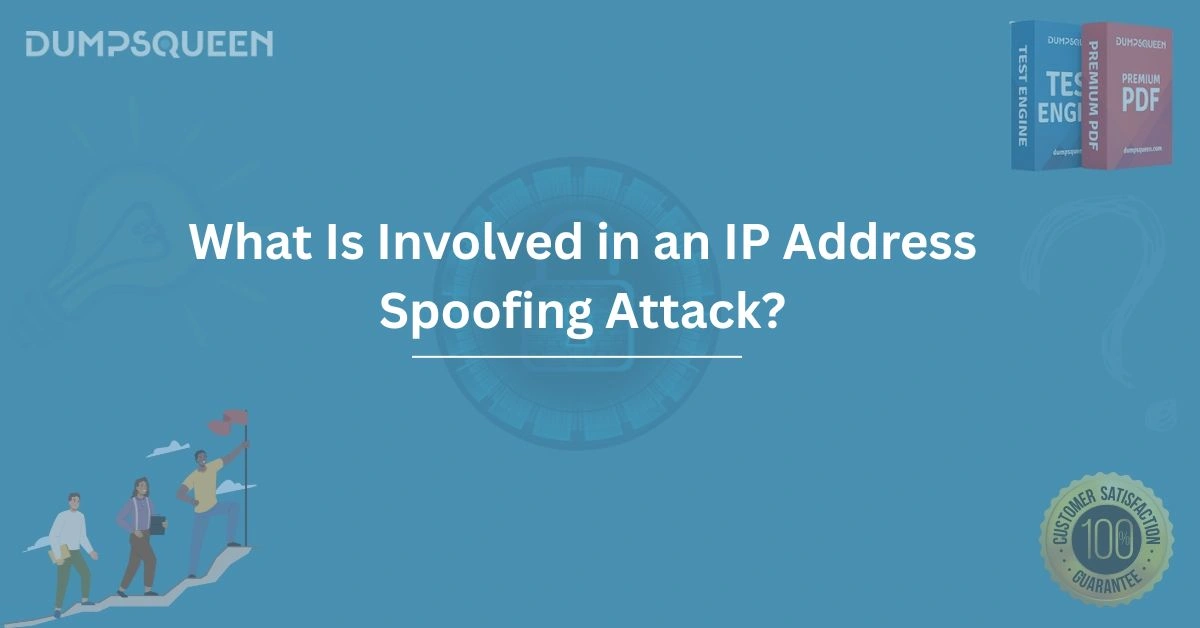Introduction
In today’s interconnected digital world, cybersecurity threats are becoming increasingly sophisticated, posing significant risks to individuals, businesses, and organizations. One such threat is an IP address spoofing attack, a technique used by cybercriminals to disguise their identity and gain unauthorized access to systems or networks. Understanding what is involved in an IP address spoofing attack is critical for protecting sensitive data and maintaining secure digital environments. At DumpsQueen, we are committed to providing valuable insights and resources to help you navigate the complex landscape of cybersecurity. This comprehensive guide explores the intricacies of IP address spoofing, its mechanisms, implications, and preventive measures, empowering you to safeguard your digital assets effectively.
Understanding IP Address Spoofing
An IP address spoofing attack involves a malicious actor manipulating the source IP address in the header of an IP packet to make it appear as though the data originates from a trusted or legitimate source. Every device connected to the internet is assigned a unique IP address, which serves as an identifier for communication between devices. By forging this identifier, attackers can deceive systems into believing that the incoming data is from a trusted entity, thereby bypassing security measures.
IP spoofing is not a standalone attack but rather a technique used to facilitate other malicious activities, such as Distributed Denial of Service (DDoS) attacks, man-in-the-middle attacks, or unauthorized access to restricted systems. The ability to impersonate a legitimate IP address makes this method particularly dangerous, as it exploits the trust-based nature of network communications.
How IP Address Spoofing Works
To understand the mechanics of IP address spoofing, it’s essential to grasp the structure of IP packets. An IP packet consists of a header and a payload. The header contains metadata, including the source and destination IP addresses, which routers use to direct the packet to its intended recipient. In a spoofing attack, the attacker alters the source IP address in the packet header to mimic a trusted device or network.
Attackers typically use specialized software or tools to craft and send these fraudulent packets. For example, they may employ packet injection tools to generate packets with forged headers. Once sent, these packets can trick the target system into processing them as legitimate, allowing the attacker to achieve their objectives, whether it’s overwhelming a server with traffic or intercepting sensitive data.
The process of spoofing is facilitated by the stateless nature of the Internet Protocol (IP), which does not inherently verify the authenticity of the source IP address. This vulnerability makes it relatively easy for attackers to manipulate packet headers, although executing a successful spoofing attack often requires additional technical expertise and planning.
Types of IP Address Spoofing Attacks
IP address spoofing can be employed in various types of cyberattacks, each with distinct goals and methods. Below are some of the most common applications of IP spoofing:
Distributed Denial of Service (DDoS) Attacks
In a DDoS attack, the attacker floods a target server or network with an overwhelming volume of traffic, rendering it inaccessible to legitimate users. IP spoofing is often used to obscure the source of the attack, making it difficult for the victim to trace and block the malicious traffic. By spoofing multiple IP addresses, the attacker can create the illusion of a coordinated attack from numerous sources, amplifying the impact.
Man-in-the-Middle (MITM) Attacks
In a man-in-the-middle attack, the attacker intercepts communication between two parties, often by spoofing the IP address of one of the communicating devices. This allows the attacker to eavesdrop on sensitive information, such as login credentials or financial data, or even alter the communication to manipulate the outcome.
Session Hijacking
Session hijacking involves an attacker taking over an active session between a user and a server. By spoofing the user’s IP address, the attacker can impersonate the user and gain access to restricted resources or perform unauthorized actions, such as transferring funds or modifying account settings.
Bypassing IP-Based Authentication
Some systems rely on IP-based authentication to grant access to specific users or devices. By spoofing an authorized IP address, an attacker can bypass these controls and gain entry to restricted systems, potentially compromising sensitive data or critical infrastructure.
Techniques Used in IP Address Spoofing
Executing an IP address spoofing attack requires a combination of technical knowledge and tools. Attackers employ various techniques to manipulate IP packets and evade detection. Some of the most common methods include:
Packet Crafting
Packet crafting involves creating custom IP packets with forged headers. Tools like Scapy or Hping allow attackers to manipulate packet fields, including the source IP address, to suit their needs. These tools are widely available and relatively easy to use, making packet crafting a popular technique among cybercriminals.
ARP Spoofing
Address Resolution Protocol (ARP) spoofing is a technique used in local networks to associate the attacker’s MAC address with the IP address of a legitimate device. By poisoning the ARP cache of a target device, the attacker can redirect traffic intended for the legitimate device to their own system, enabling further attacks like session hijacking or data interception.
Proxy Servers and VPNs
While proxy servers and Virtual Private Networks (VPNs) are often used for legitimate purposes, attackers can exploit them to mask their true IP address. By routing their traffic through a proxy or VPN, attackers can make it appear as though their packets originate from a different location, complicating efforts to trace the attack.
Botnets
In large-scale attacks like DDoS, attackers may leverage botnets—networks of compromised devices—to distribute spoofed packets. Each device in the botnet can be programmed to send packets with forged IP addresses, creating a massive volume of traffic that overwhelms the target.
Challenges and Limitations of IP Spoofing
While IP address spoofing is a powerful technique, it is not without its challenges and limitations. One significant hurdle is the bidirectional nature of most network communications. For an attack to succeed, the attacker must not only send spoofed packets but also receive responses from the target. Since responses are sent to the forged IP address, the attacker must employ additional techniques, such as network sniffing or session hijacking, to intercept these responses.
Additionally, modern network security measures, such as ingress and egress filtering, can detect and block spoofed packets. Ingress filtering verifies that incoming packets have valid source IP addresses, while egress filtering ensures that outgoing packets from a network have legitimate source addresses. These mechanisms significantly reduce the effectiveness of spoofing attacks.
Another limitation is the complexity of executing a successful spoofing attack. Crafting convincing packets, evading detection, and achieving the desired outcome require a deep understanding of networking protocols and security systems. As a result, IP spoofing is often used by skilled attackers or organized cybercrime groups rather than casual hackers.
Impacts of IP Address Spoofing Attacks
The consequences of a successful IP address spoofing attack can be severe, affecting individuals, businesses, and even entire industries. Some of the most significant impacts include:
Financial Losses
Spoofing attacks that lead to data breaches or unauthorized transactions can result in substantial financial losses. For example, a man-in-the-middle attack that intercepts banking credentials can enable attackers to drain accounts or make fraudulent purchases.
Data Breaches
By bypassing security controls, attackers can gain access to sensitive information, such as customer data, intellectual property, or trade secrets. These breaches can damage an organization’s reputation and lead to legal and regulatory consequences.
Service Disruptions
DDoS attacks powered by IP spoofing can disrupt critical services, such as e-commerce platforms, online banking, or government websites. These disruptions can erode customer trust and result in lost revenue.
Reputational Damage
A high-profile spoofing attack can tarnish an organization’s reputation, particularly if it results in a data breach or prolonged service outage. Rebuilding trust with customers and stakeholders can be a lengthy and costly process.
Preventing IP Address Spoofing Attacks
Preventing IP address spoofing requires a multi-layered approach to network security. By implementing robust defenses and best practices, organizations can significantly reduce their vulnerability to these attacks. Below are some effective strategies:
Implementing Packet Filtering
Network administrators should deploy ingress and egress filtering to block packets with invalid or suspicious source IP addresses. These filters can be configured at the router or firewall level to ensure that only legitimate traffic is allowed to enter or leave the network.
Using Encrypted Protocols
Encrypted communication protocols, such as HTTPS, TLS, or IPsec, can prevent attackers from intercepting or manipulating data. Encryption ensures that even if a packet is spoofed, the attacker cannot access or alter the contents without the encryption key.
Strengthening Authentication Mechanisms
Relying solely on IP-based authentication is risky. Instead, organizations should implement multi-factor authentication (MFA) and strong password policies to ensure that only authorized users can access sensitive systems, even if an attacker spoofs an IP address.
Monitoring Network Traffic
Continuous monitoring of network traffic can help detect anomalies associated with spoofing attacks, such as unusual spikes in traffic or packets with inconsistent headers. Intrusion detection systems (IDS) and intrusion prevention systems (IPS) can provide real-time alerts and automatically block malicious activity.
Educating Employees
Human error is often a weak link in cybersecurity. Regular training programs can educate employees about the risks of spoofing attacks and teach them to recognize phishing attempts or suspicious network activity. A well-informed workforce is a critical line of defense.
Leveraging Advanced Security Tools
Advanced security solutions, such as next-generation firewalls, anti-DDoS services, and threat intelligence platforms, can provide comprehensive protection against spoofing attacks. These tools use machine learning and behavioral analysis to identify and mitigate threats in real time.
The Role of DumpsQueen in Cybersecurity Education
At DumpsQueen, we understand the importance of staying ahead in the ever-evolving field of cybersecurity. Our platform offers a wealth of resources, including study guides, practice exams, and expert insights, to help professionals and organizations enhance their security knowledge and skills. Whether you’re preparing for a certification exam or seeking to deepen your understanding of threats like IP address spoofing, DumpsQueen is your trusted partner in achieving cybersecurity excellence.
By providing accessible, high-quality educational content, DumpsQueen empowers individuals and businesses to build robust defenses against cyber threats. Our commitment to fostering a secure digital world drives us to deliver accurate, up-to-date information that you can rely on.
Conclusion
IP address spoofing is a sophisticated and potentially devastating technique used by cybercriminals to exploit vulnerabilities in network communications. By understanding what is involved in an IP address spoofing attack—its mechanisms, applications, and impacts—you can take proactive steps to protect your digital assets. From implementing packet filtering and encrypted protocols to leveraging advanced security tools and education, a comprehensive approach to cybersecurity is essential in today’s threat landscape.
At DumpsQueen, we are dedicated to equipping you with the knowledge and resources needed to stay ahead of cyber threats. By fostering a deeper understanding of techniques like IP spoofing, we empower you to build secure, resilient systems that withstand even the most advanced attacks. Stay vigilant, stay informed, and let DumpsQueen be your guide in navigating the complex world of cybersecurity.
Free Sample Questions
-
What is the primary purpose of IP address spoofing?
a) To encrypt network traffic
b) To disguise the source of an IP packet
c) To increase network speed
d) To authenticate users
Answer: b) To disguise the source of an IP packet -
Which type of attack commonly uses IP spoofing to overwhelm a target with traffic?
a) Phishing attack
b) Distributed Denial of Service (DDoS) attack
c) SQL injection attack
d) Cross-site scripting attack
Answer: b) Distributed Denial of Service (DDoS) attack -
What is a key limitation of IP address spoofing attacks?
a) They are impossible to execute
b) Responses are sent to the forged IP address
c) They cannot target large networks
d) They require physical access to the target
Answer: b) Responses are sent to the forged IP address -
Which security measure can help prevent IP spoofing?
a) Disabling firewalls
b) Implementing ingress and egress filtering
c) Using unencrypted protocols
d) Reducing network monitoring
Answer: b) Implementing ingress and egress filtering



